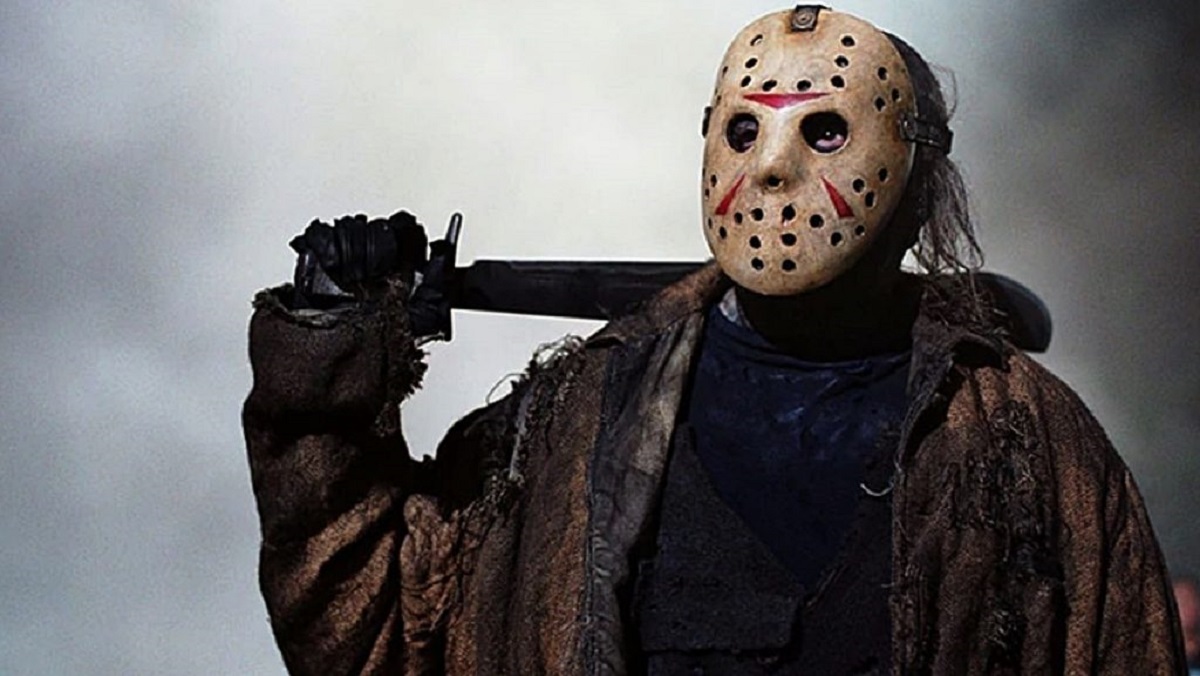
BODY HORROR “KILL YOUR LOVER” NOW AVAILABLE ON VOD IN UK & IRELAND
KILL YOUR LOVER (Winner of Dead Northern’s Best Feature 2024), a razor-sharp and visceral exploration

Sean S. Cunningham’s 1980 hit Friday the 13th is undeniably a staple within the slasher sub-genre, with its chartered success spawning an entire franchise consisting of twelve films. The film has rightly cemented its place within horror history as a genre defining tale that combines the ideal amount of gory entertainment, teenage antics and grisly kills to satisfy audience members. Still, it’s the machete wielding immortal force that makes Friday the 13th so iconic – the one and only Jason Voorhees.

To run a brief background, Jason Voorhees is the primary antagonist in the film series, with a machete being his weapon of choice. To accompany his machete is his hockey mask which he’s rarely seen without. His taste for bloodshed all began with his troubling experience at Camp Crystal Lake in the summer of 1957 where he supposedly drowned due to the negligent camp counsellors. His rage however is not as straightforward as it seems. His own personal vengeance only directly advances in Friday the 13th Part 2 (Steve Miner, 1981).
Throughout the series Jason is very much pliable in the sense that his actions, locations and abilities change. However there is one element that remains consistent across the films, this being Jason’s tragic cycle that he has to endure. This was most poignantly made visible from the horror legend Stephen King who made a statement regarding a scenario he had created surrounding a previous novel idea he never made. He compared Jason’s existence to a ‘hellish existential fate’ and that Jason’s perspective is never explained or understood.

With this being said, it’s important to examine Jason’s catharsis throughout the series to grasp why he is a victimised villain.
Jason Voorhees is a tortured soul that possesses an inherent thirst for normality, but due to the lack thereof he has become incandescent with rage. His trouble began whilst he was only a boy, with his severe mental disabilities and physical deformities making him an easy target for cruelty growing up. His brief stay at Camp Crystal Lake only worsened his everlasting marginalisation from societal normality. He was bullied and teased at the camp, with his death being brushed aside as not an overt loss.
Jason’s only companion was his mother who worked at the camp; he would spend most of his time with her, leading to his peers mistreating him. This neglectful nature followed Jason to his death. As aforementioned the counsellors cared more for each other than his well-being. Even after his death, his corpse was never found. Which prominently led to Pamela vowing to kill anyone who steps foot on Camp Crystal Lake as she believes everyone is out to attack her son.

Jason suffered from a short-lived tumultuous childhood, but the true treacherous fragment of his being comes from his afterlife. The theology of his immortal status is rather discombobulated across the films, the first film hints that the lack of his corpse is more of an urban legend, toying with the notion ‘is he dead or alive?’; in Friday the 13th Part 2 it’s established that Jason has been alive since his supposed drowning and has been living as a vagrant in the woods.
This perfectly brings about Jason’s real introduction to the series, which would soon introduce him as a household name. In Part 2 he vows to avenge his mother’s death, leading him to follow her footsteps. In fact, he treasures his mother so much that he stores her decapitated head in a fridge. Whilst the second film establishes Jason’s urge to kill, his trademarks do not necessarily appear until Friday the 13th Part 3 (Steve Miner, 1982). Here we are introduced to his trademark hockey mask, which cements his place as an iconic villain. Additionally, the audience is shown a whisper of insight into his burrowing nature to kill. After he kills his mother’s murderer, Alice (Adrienne King [the series original final girl]) he has technically performed his prior intentions.
From then on his remorseless kills originate seemingly from a place of nothing. Jason’s fury was soothed after he murdered Alice, but he knows no better than to carry on his rampage. It could be said that Jason isn’t even aware of the consequences of his actions.

Although Jason is a structurally massive killing machine with brute strength, he hasn’t matured mentally. Slasher films heavily associate sex with violence, yet whilst Jason victims are simply exploring adulthood he views it as immoral, since his own supposed death was caused due to camp counsellors occupying each other rather than watching after him. This sense of Jason unknowingly causing harm continues throughout the entirety of the franchise, with his lack of motivation or reason to kill. However what really makes the audience team with Jason is his unsanctioned resuscitation.
In Friday the 13th: The Final Chapter (Joseph Zito, 1984) Jason is supposed to be dead, with him even being taken to a morgue, but as usual this is not entirely true. We are then taken back to Crystal Lake as Jason makes his way back home in an attempt to beckon back to his resting place. Instead of peace, he is met with rowdy teenagers and noisy families in his area interrupting his will to slumber into a dreary space of emptiness. Henceforth, his killing spree continues as a means to end the disruption.

However in what is a startling scene, we are met with the horror aficionado Tommy (Corey Feldman) who paints his face white and shaves his head to imitate a young Jason in order to force a sense of sympathy from him. His impression comes across as a form of mockery, further angering Jason. Arguably Jason simply sees Tommy as another one of his childhood bullies who would tease him for his appearance. Jason is supposedly killed at the end of The Final Chapter, but we would later learn that this is not his final appearance.

The combination of mocking and disallowance for him to die is what Stephen King brought to light. His existence is hellish and rather existential, through others actions he can never fully rest in peace as he is constantly unearthed. Even when he is not the antagonist the series finds a way to drag him into the mess; in what is the most dissociated film in the franchise, with a new setting and killer is Friday the 13th: A New Beginning (Danny Steinmann, 1985). In the film Tommy is sent to Pinehurst Halfway House to recover from his childhood trauma, whilst he is there a series of mysterious killings occur. Instead of the hockey mask machete-wielding killer being Jason it is in fact a disgruntled father who is out for revenge for his son’s untimely death.
After ‘A New Beginning’ came Friday the 13th Part VI: Jason Lives (Tom McLoughlin, 1986) which sees Jason being accidentally resurrected from his grave. When Tommy returns to Jason’s grave years later he is overcome with anger and stabs Jason with a metal fence post. However as the post hits Jason a bolt of lightning strikes and revives a now immortal Jason. Similarly, another accidental reviving occurs in both Friday the 13th Part VII: The New Blood (John Carl Buechler, 1988) and Friday the 13th Part VIII: Jason Takes Manhattan (Rob Hedden, 1989). In both films repeat occurrences happen where Jason is involuntarily awoken and then goes on a rampage with a sense of angered dread, due to the repetitive nature of his life cycle. It seems that the universe disallows Jason to remain dead. The characters wince that Jason is after them, but it is their actions that unwittingly cause the vicious pattern.

Quite ironically in the ninth film Jason Goes to Hell: The Final Friday (Adam Marcus, 1993) Jason lives on due to a coroner biting his heart, causing him to possess said coroner; living on in the coroner’s body. However in what is quite the twist of fate, the repetitive ending of Jason ‘being dead’ is given a new lease of life, with the ending hinting at what would be an iconic meeting between two horror legends. The final frame shows a dog digging at Jason’s buried mask before A Nightmare on Elm Street’s own Freddy Kreuger pulls the mask down into hell.
Before we are introduced to the crossover film we have Jason X (Jim Issac, 2001). This is probably the most convoluted film of the series, with its adventurous sci-fi tone somehow combining slasher with space. Jason X definitely has divided opinions, with many devoted fans feeling confused as to why there needed to be such a drastic alteration from the usual time and place and others seeing it as a cult classic that bends audience expectations. In terms of Jason himself, nothing immediately differs from his archetypal persona in space. Instead where we see a shift in motion is in the series current penultimate film Freddy vs. Jason (Ronny Yu, 2003).

Freddy vs. Jason is highly entertaining, with the two characters showcasing a brutal spectacular series of violently glorious kills across a group of unsuspecting teens. The film shows a ruthless Jason who rises from the earth when Freddy impersonates his mother, in order to manipulate him into coming back to life. Freddy has Pamela tell Jason that he never died, he was just sleeping and that he should go to Elm Street as “the children have been very bad on Elm Street”. Here it’s confirmed that Jason is acting on a means to obey and order via his mother’s wishes; he only seeks to punish as it’s what his only beloved trustee believes. It’s clear that Jason’s hellish fate derived from his attachment issues with his mother. He has remained a child mentally, with his mother having a psychologically overbearing influence for his whole existence.

It seems that Friday the 13th will never come to a conclusive end, with the final film so far – Friday the 13th (Marcus Nispel, 2009) latently repeating the pattern all over again. This film is a remake of the first and disregards all the previous entries. The ending remains eerily similar to the original, with Jason lurching out one more time in a lake at the final girl. Devastatingly enough the repeating of final frames indicate that the process has started all over again.

Jason is corruptly entangled with his obsolete moral compass focused on him and his mother’s neurotic relationship together. His unfortunate trauma has never faded and no matter what ill-conceived acts he commits it’s difficult to feel hatred towards him. Somehow we are routing for Jason the majority of time, with his victims seeming rather disposable and unworthy of true survivor status. Pamela will always have a hold on Jason and will always encourage his murderous tendencies, leading to a vicious cycle where he must live forever to kill.
This weeks article comes via Grace from Film Overload, you can check out more of her work here.




KILL YOUR LOVER (Winner of Dead Northern’s Best Feature 2024), a razor-sharp and visceral exploration

Amy (Hannah Deale) barely scrapes by; working two thankless jobs whilst simultaneously caring for her

In 2022 M3GAN dominated screens and for the most part, created a cult fanbase who

British director Danny Boyle and writer Alex Garland compelled the masses with their triumphant ‘28